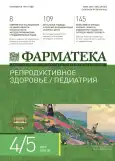Current approaches to the treatment of functional constipation in children
- 作者: Ermolenko K.D.1, Kirilenko L.A.1, Dolgikh V.V.2
-
隶属关系:
- Children’s Scientific and Clinical Center for Infectious Diseases of the Federal Medical and Biological Agency
- LLC Zdorovy Khleb
- 期: 卷 30, 编号 4/5 (2023)
- 页面: 109-114
- 栏目: Original articles
- ##submission.datePublished##: 05.08.2023
- URL: https://journals.eco-vector.com/2073-4034/article/view/568051
- DOI: https://doi.org/10.18565/pharmateca.2023.4-5.109-114
- ID: 568051
如何引用文章
详细
Background. Among all functional gastrointestinal disorder, the most common nosological form is functional constipation (FC). In Western countries, it is estimated to be diagnosed in 2–27% of the population. The expansion of ideas about the mechanisms of the formation of FC contributes to the expansion of the possibilities of treating this condition.
Objective. Evaluation of the effectiveness of various treatment regimens for FC in children.
Methods. The study included 106 patients aged 4 to 17 years, 51 (48.1%) were boys and 55 (51 .9%) girls, who underwent outpatient treatment due to FC at the Consultative and Diagnostic Center of the Children’s Scientific and Clinical Center for Infectious Diseases of the Federal Medical and Biological Agency. Rome IV criteria were used for the diagnosis of FC. Drug treatment of FC was carried out in three groups formed in accordance with the treatment regimen: group 1 – lactulose (n=39), group 2 – functional food product (FPP) “multi-grain protein-spelled” bread (n=33), group 3 – lactulose+FPP functional “multi-grain protein-spelled” bread (n=34). Intestinal microbiocenosis in children was assessed at the beginning of treatment and on the 21st day by examining fecal samples by real-time PCR, which was performed at the Department of Molecular Microbiology, Institute of Experimental Medicine.
Results. Complete pain relief after the course of treatment was achieved in 64 children (60.4%). Depending on the chosen drug regimen, there were significant differences in the frequency of complete long-term relief of FC symptoms: in group 1 – in 21 (53.8%), in group 2 – in 19 (57.6%), in group 3 – in 24 (70, 6%). Decrease in the Lactobacillus spp. and Bifidobacterium spp. level was most typical. This indicator was lower than the reference values by 2 lg CFU/g in 22 children from group 3 (64.7.7%) and 24 children from group 2 (72.7%). It should also be noted that the use of functional bread “protein spelled many grains” contributed to the restoration of normal levels of these parameters.
Conclusion. Combination therapy of FC using functional bread “protein spelled many grains” in combination with laxatives increases the effectiveness of treatment, providing a significantly more effective restoration of microbiocenosis parameters and a reduction in the duration of clinical symptoms. The use of functional bread “protein spelled many grains” as monotherapy also had an effect on the symptoms of the disease, contributing to the normalization of the frequency of bowel movements and the reduction of symptoms associated with stool retention.
全文:
作者简介
Konstantin Ermolenko
Children’s Scientific and Clinical Center for Infectious Diseases of the Federal Medical and Biological Agency
编辑信件的主要联系方式.
Email: ermolenko.kd@yandex.ru
ORCID iD: 0000-0002-1730-8576
Cand. Sci. (Med.), Researcher at the Department of Intestinal Infections
俄罗斯联邦, St. PetersburgL. Kirilenko
Children’s Scientific and Clinical Center for Infectious Diseases of the Federal Medical and Biological Agency
Email: ermolenko.kd@yandex.ru
ORCID iD: 0009-0004-5129-8107
俄罗斯联邦, St. Petersburg
V. Dolgikh
LLC Zdorovy Khleb
Email: ermolenko.kd@yandex.ru
ORCID iD: 0000-0003-1150-4530
俄罗斯联邦, St. Petersburg
参考
- Sperber Ami D., et al. Worldwide prevalence and burden of functional gastrointestinal disorders, results of Rome Foundation Global Study. Gastroenterology. 2021;160(1):99–114.e3. doi: 10.1053/j.gastro.2020.04.014.
- Ermolenko K.D., Gonchar N.V., Ermolenko E.I., et al. The role of acute intestinal infections of viral etiology in the development of functional pathology of the gastrointestinal tract in children. Farmateka. 2016;1(314):55–61. (In Russ.).
- Koppen I.J., Nurko S., Saps M., et al. The pediatric Rome IV criteria: what’s new? Exp Rev Gastroenterol Hepatol. 2017;11(3):193–201. doi: 10.1080/17474124.2017.1282820.
- Cifci I., Gokdemir O., Aygun O., Guldal D. Evaluation of functional constipation frequency and related factors. Fam Pract. 2023;40(2):268–72. doi: 10.1093/fampra/cmac108.
- Alonso-Bermejo C., et al. Functional gastrointestinal disorders frequency by Rome IV criteria. An Pediatr (English Edition). 2022;96(5):441–47. doi: 10.1016/j.anpede.2021.05.013.
- Velasco-Benitez C.A., Collazos-Saa L.I., Garcia-Perdomo H.A. Functional Gastrointestinal Disorders in Neonates and Toddlers According to the Rome IV Criteria: A Systematic Review and Meta-Analysis. Pediatr Gastroenterol Hepatol Nutr. 2022;25(5):376–86. doi: 10.5223/pghn.2022.25.5.376.
- Schmulson M J., Drossman D.A. What is new in Rome IV. J Neurogastroenterol Motil. 2017;23(2):151. doi: 10.5056/jnm16214.
- Ermolenko K.D. he structure of the functional pathology of the digestive system in children after viral intestinal infections. Gastroenterologiya Sankt-Peterburga. 2017;1:59–63. (In Russ.).
- Ermolenko K.D., Gonchar N.V., Lobzin Yu.V. et al. Prediktory formirovanija funkcional’nyh rasstrojstv zheludochno-kishechnogo trakta posle norovirusnoj infekcii u detej. Zhurnal infektologii. 2017;9(2):42–47. (In Russ.).
- Ermolenko K.D., Gonchar N.V., Ermolenko E.I., Lobzin Yu.V. Violation of intestinal microbiocenosis as a factor in the formation of post-infectious pathology of the digestive system in children after viral intestinal infections. Eksperimental’naya i klinicheskaya gastroenterologiya. 2017;(1):53–7. (In Russ.).
- Ermolenko K.D., Gonchar N.V., Skripchenko N.V. The defeat of the organs of the gastrointestinal tract with a new coronavirus infection in children. Zhurnal im. G.N. Speranskogo. 2020;99(6):135–40. (In Russ.).
补充文件








